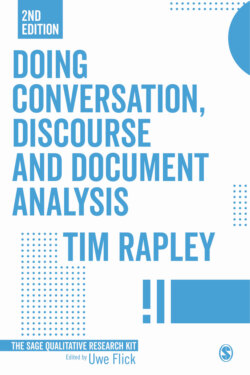Читать книгу Doing Conversation, Discourse and Document Analysis - Tim Rapley - Страница 13
На сайте Литреса книга снята с продажи.
Some thoughts on what is to come
ОглавлениеThis book is designed to offer you access to ‘the craft skill’ of collecting and working with discourse from a range of contexts and a range of perspectives. The next chapter discusses how to generate your research archive – the ‘dataset’ that you will find yourself working with on a day-to-day basis. I offer you a brief tour of the massive range of researchable materials that are potentially available to you. I also provide some examples of how I and other researchers found, collected and analyzed various materials. Chapter 3 then shifts to a discussion of ethics and confidentiality. I outline some general principles you should consider as well as some more detailed guidelines that may help you think about your specific research project. Thinking about the ethical implications of your research is never just a bureaucratic or organizational requirement or hurdle. It is essential that anyone who wants to conduct research has respect for those people they are researching, and demonstrates this with their actions throughout the life of the project.
The next two chapters focus on the generation and transcription of audio and video recordings. Chapter 4 outlines the types of recording devices that are currently available. It then goes on to discuss how to recruit participants, generate research questions and record field encounters. Each of these three issues is discussed in relation to both so-called ‘researcher-prompted data’ – focus group or interview-based research – and so-called ‘naturally occurring data’ – audio- or video-based ethnographies of action and interaction. Chapter 5 then outlines different ways that you can transcribe the recordings that you generate. I use some materials that I have collected – a recording of people preparing a meal – to demonstrate some of the different ways that you can transcribe the same recording.
In Chapter 6, I then focus on how you can study talk and conversations. I show how people, mainly from the research traditions of conversation analysis and discursive psychology, work with audiotapes and videotapes of talk and interaction. Through a discussion of a range of transcripts of talk, I outline some of the key features of talk that people often focus on when analyzing conversations. The next chapter shifts to exploring how documents and texts are created, used and spoken for in various contexts. It focuses on how documents, and other ‘non-human things’ (like pens or computers), co-ordinate and produce people’s actions and interactions. Through three case studies, I extend the prior chapter’s discussion on how to study talk, and outline how a detailed analysis of moments of talk can say something about the ‘big’ structures and institutions of social life.
Chapter 8 outlines some of the dilemmas that you can face when you study conversations and discourse. I outline the debates around such topics as how best to understand and work with interview or focus group data: what is your role in making claims about what is going on in your data; and what can a detailed analysis of talk say about things like ‘power’? Chapter 9 then focuses on the analysis of ‘texts’ or ‘documents’. Through a range of examples and case studies, I offer you some potential ways to engage with different varieties of texts. The chapter begins with an example of a detailed analysis of a couple of lines from a newspaper dating advertisement and ends with a discussion of some documents ranging over a 50-year period. The aim of this chapter is to give you access to a range of questions and tactics you might want to adopt when engaging with texts.
The closing chapter offers a broad overview on how to code and analyze all types of discursive materials. It draws together approaches to questioning the quality of analysis. I also outline some main ‘stepping-stones’ when undertaking this style of work, a list of things you may want to consider in relation to how you undertake your own work. In each chapter, the emphasis is on the practicalities of doing such work. I have tried to ground my discussion in a range of – hopefully interesting – empirical examples of how people have actually generated, worked on and theorized with different research materials. Importantly, in writing this book I am not seeking to offer you a set of specific criteria that ‘must’ be followed, but rather I have tried to suggest a range of approaches, techniques and practices that should help you begin to engage with and undertake discursive work.
